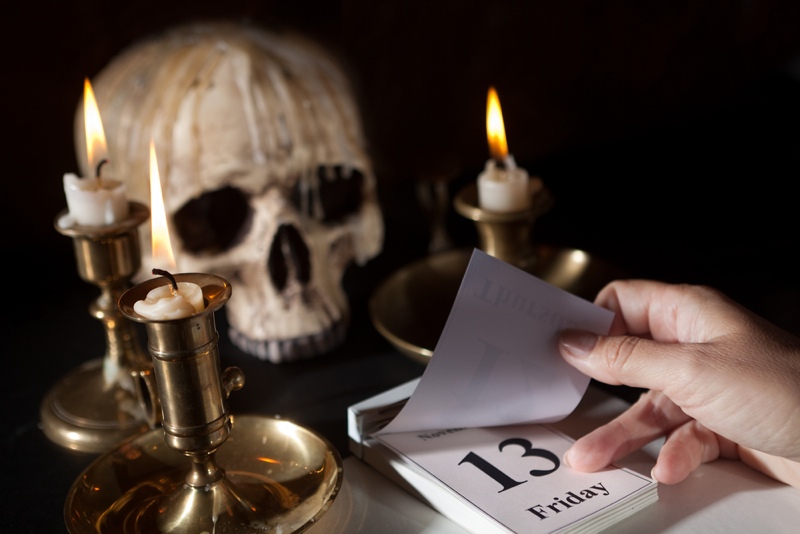Origins of Friday the 13th: How the Day Got So Spooky

Bad luck comes in twos in 2017. This year features a duo of Friday the 13ths, the second of which occurs today (Oct. 13). The first myth-mired Friday fell on Jan. 13 this year.
Today, it's taken for granted that Friday the 13th is an inauspicious day, but that wasn't always the case. Until the late 1800s, no one felt that Fridays that happen to fall on the 13th day of the month were anything special at all.
Exactly how the date became mired in the mind as an unlucky one is murky. Certainly the idea was firmly implanted in the cultural consciousness by 1980, when the slasher flick "Friday the 13th" was released. The hockey-masked villain of that tale, Jason Voorhees, has taken on a life of his own, driving 12 films as well as multiple novellas and comic books. Thus, it's no surprise that a Google Ngram search of the phrase "Friday the 13th" finds the term shot up in use in books in 1980. [The Surprising Origins of 9 Common Superstitions]
Credit for popularizing the Friday the 13th myth often goes to Capt. William Fowler, a noted soldier who rubbed elbows with former presidents and other high-profile people of the late 1800s. Fowler noticed that the number 13 was woven throughout his life (he went to Public School No. 13 in New York City, for example, and fought in 13 Civil War battles), so he decided to combat the "popular superstition against thirteen," according to his obituary.
Fowler started a society called the Thirteen Club, which held its first meeting on Sept. 13, 1881. Guests walked under crossed ladders to a 13-seat table festooned with spilled salt. It was a notable party and repudiation of superstition, but Fowler can't take credit for Friday the 13th, specifically: Sept. 13, 1881, was a Tuesday. (Another account, detailed in a blog by the New York Historical Society, puts that inaugeral meeting on a Friday the 13th — Jan. 13, 1882, at 8:13 p.m., in room 13 of Fowler's Knickerbocker Cottage.)
That idea that 13 was an unlucky number may go back to ancient mythology. According to Donald Dossey, author of "Holiday Folklore, Phobias and Fun" (Outcome Unlimited Pr, 1992), a Norse myth told of a dinner party for 12 gods at which a 13th guest showed up uninvited. The gatecrasher — the trickster god Loki — shot the god of joy and happiness, Balder. The Christian tale of the Last Supper likewise holds Judas, Jesus' betrayer, as the "unlucky" 13th guest.
Friday has also been considered an unlucky day in Western tradition. E. Cobham Brewer's 1898 "Dictionary of Phrase and Fable" claims Friday as the day that Jesus was crucified and perhaps the day that Adam and Eve ate the forbidden fruit in the Garden of Eden, according to Christian beliefs. In 1882, poet John Godfrey Saxe published a poem called "The Good Dog of Brette," about a poodle that roams the city with a basket, bringing donations home to his blind master. On a Friday, "a day when misfortune is aptest [sic] to fall," a cruel butcher chops off the dog's tail.
Get the world’s most fascinating discoveries delivered straight to your inbox.
In 1907, author Thomas William Lawson put together the notion of unlucky Friday and unlucky 13 with the novel "Friday the 13th," a tale of an unscrupulous broker taking advantage of superstition to game the stock market on that date, described as "Wall Street hoodoo-day." Lawson may not have invented the idea of the unlucky date, but he likely spread the notion.
Original article on Live Science.
Editor's Note: This article was first published in 2015 and updated on Oct. 13, 2017.

Stephanie Pappas is a contributing writer for Live Science, covering topics ranging from geoscience to archaeology to the human brain and behavior. She was previously a senior writer for Live Science but is now a freelancer based in Denver, Colorado, and regularly contributes to Scientific American and The Monitor, the monthly magazine of the American Psychological Association. Stephanie received a bachelor's degree in psychology from the University of South Carolina and a graduate certificate in science communication from the University of California, Santa Cruz.
